Examination of Cerebrospinal Fluid (CSF)
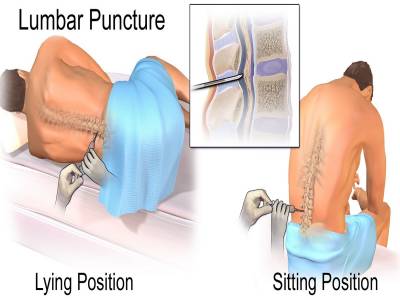
It is a clear, colorless fluid formed in the ventricles of the brain mainly by choroid plexus (an interlaced structure or meshwork of tiny small blood vessels in the lateral third and fourth ventricles). It is mainly an ultrafiltrate of plasma.
Cerebrospinal fluid (CSF) is contained within the cerebral ventricles, the spinal canal and the subarachnoid space (space between arachnoid externally and pia mater internally) surrounding the brain and spinal cord (Figure 1182.1). Cerebrospinal fluid (CSF) is reabsorbed into the blood through the arachnoid villi of dural venous sinuses.
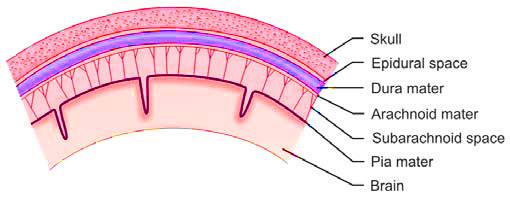
COMPOSITION OF NORMAL CEREBROSPINAL FLUID IN ADULTS
- Total volume: 100-150 ml (10-60 ml in the newborn
- Color: Colorless
- Appearance: Clear
- Clot: Absent
- Viscosity: Similar to water
- Opening pressure: 60-180 mm of water (10-100 mm in infants and young children)
- Cells:
– Adults: 0-5 cells/cmm
– Infants: 0-30 cells/cmm
– 1-4 years: 0-20 cells/cmm
– 5-18 years: 0-10 cells/cmm - Glucose: 45-80 mg/dl. (Normally CSF glucose is 60% or 2/3rds of blood glucose)
- Proteins: 15-45 mg/dl. (Normally CSF proteins are 1% of plasma proteins)
- Bilirubin: Absent
- Chloride: 120-130 mEq/L (20 mEq/L more than serum level)
- Oligoclonal bands: Negative
FUNCTIONS OF CEREBROSPINAL FLUID
- It acts as a shock absorber and protects the brain and spinal cord from injury.
- To serve as a medium between blood and brain for the supply of nutrients to and removal of waste products from the brain.
COLLECTION OF CEREBROSPINAL FLUID
Some diseases produce characteristic alterations in the composition of the cerebrospinal fluid, thus providing the basis for examination of cerebrospinal fluid. The first lumbar puncture or LP was performed in 1891 by Quincke for the collection of the sample of cerebrospinal fluid. For the collection of cerebrospinal fluid from the subarachnoid space (Figure 1182.2), spinal or LP needle is passed between 3rd and 4th or between 4th and 5th lumbar vertebra (L3-L4 or L4-L5). LP is carried out at these levels in order to prevent injury to the spinal cord (spinal cord ends at about T12, below which are cauda equina or nerve roots).
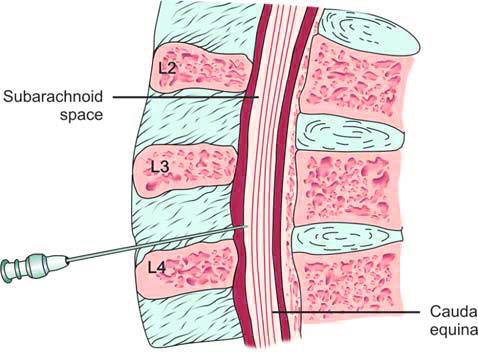
The patient is in a side-lying (lateral recumbent) position with his back absolutely vertical and at the edge of the bed, with the knees drawn up and the head flexed onto his chest. This position increases the space between the lumbar vertebrae. Alternately, the patient may be in a sitting position.
The selected site is disinfected with the chlorhexidine-containing solution or povidone-iodine, covered with sterile drapes, and after injecting a local anesthetic, a sterile lumbar puncture needle, preferably 22 gauges (Figure 1182.3), is inserted slowly. An increased resistance is observed as the needle passes through the spinal ligaments and dura mater. As the needle enters the subarachnoid space, a sudden 'give' (or loss of resistance) is felt. The stylet is withdrawn slowly. When the drops of cerebrospinal fluid appear, a pre-assembled manometer is attached to the needle in order to record the opening pressure of cerebrospinal fluid (CSF). The patient should be in the lateral recumbent position for the measurement of opening pressure.

With the help of three-way stopcock in an appropriate position, cerebrospinal fluid (CSF) is collected in sterile plain tubes as follows (Figure 1182.4):
- Tube 1: Chemistry (For the glucose, protein and other serology tests)
- Tube 2: Microbiology (Gram's staining, bacterial culture, and sensitivity)
- Tube 3: Hematology (Total cell count and differential count)
- Tube 4: Cytology, special studies
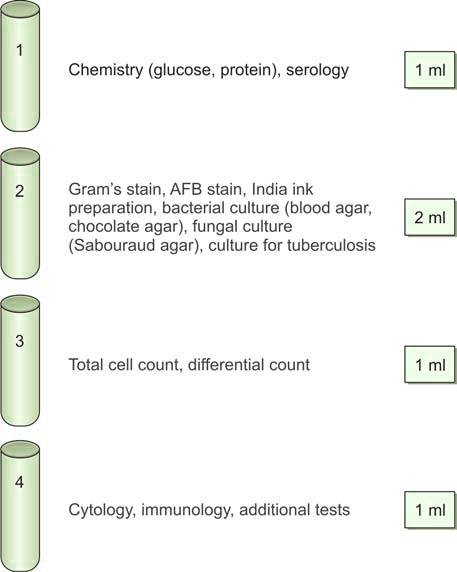
Usually, 3-5 ml of CSF is collected. If the opening pressure was high, the closing pressure is recorded after the collection of cerebrospinal fluid (CSF).
The needle is withdrawn after replacing the stylet, and a sterile dressing is applied. A venous blood sample is also obtained for the determination of glucose level in blood.
INDICATIONS FOR LUMBAR PUNCTURE
- Examination of cerebrospinal fluid (CSF) is done if the patient is suspected with the following diseases:
• Meningeal involvement by leukemia or malignancy
• Infections in the central nervous system (CNS), especially meningitis (inflammation of leptomeninges) and encephalitis
• Subarachnoid hemorrhage (if CT scan is not available)
• Inflammatory diseases, e.g. Guillain-Barré syndrome, multiple sclerosis (for diagnostic gammaglobulin findings)
• Neoplasms of the central nervous system (CNS).
Indications for emergency lumbar puncture are shown in Table 1182.1. - Administration of medications:
• Antibiotics (eg. amphotericin B in fungal meningitis)
• Anesthetic agents
• Anticancer drugs (e.g. methotrexate in acute lymphoblastic leukemia) - To reduce the pressure of cerebrospinal fluid (CSF) in benign intracranial hypertension (pseudotumor cerebri)
- Introduction of radiographic contrast media for myelography
- For Queckenstedt's test: If the opening pressure of cerebrospinal fluid (CSF) is normal and clinically subarachnoid block or a tumor or a sinus thrombosis is suspected, then Queckenstedt's test may be performed. However, the test is contra-indicated if the pressure of cerebrospinal fluid (CSF) is raised since it can precipitate herniation of the brain. There is a direct correlation between cerebrospinal fluid (CSF) pressure and pressure in the jugular vein (because of continuity with dural venous sinuses in which arachnoid villi project). In Queckenstedt's test, both jugular veins are compressed and then released, and subsequent changes in CSF pressure are observed. Normally, upon compression of jugular veins, CSF pressure rapidly rises and with the release of pressure on jugular veins, CSF pressure rapidly falls. In the presence of a spinal block, there is no rise of CSF pressure with jugular vein compression (or a pressure rise is low or delayed). This test is positive in about 80% of patients with cord compression. With the advent of myelography, Queckenstedt's test is rarely performed.
|
COMPLICATIONS OF LUMBAR PUNCTURE
- Post-puncture headache: This is the most common side effect and results from leakage of CSF from puncture site at a rate faster than the rate of CSF production. With the use of a large bore needle, greater CSF leak occurs. Use of a smaller bore needle (22 G) for LP and keeping the patient flat after the procedure for 2-3 hours reduces the risk of headache.
- Introduction of infection in spinal canal if aseptic precautions are not observed, if septicemia is present, or if infection is present at the site of LP.
- Subdural hematoma with resultant neurologic deficit in patients with bleeding diathesis.
- Failure to obtain CSF (dry tap) which may be due to the incorrect positioning of the patient or spinal block.
- Herniation of brain through tentorium (uncus of temporal lobe) or foramen magnum (cerebellar tonsils), if intracranial pressure is high. This can damage the brainstem. This risk has led to the reduced use of lumbar puncture over the last few years.
- Subarachnoidal epidermal cyst (due to traumatic implantation of a skin plug in subarachnoid space) may develop after a few years if LP is preformed without a stylet.
CONTRAINDICATIONS TO LUMBAR PUNCTURE
- Raised intracranial pressure due to a spaceoccupying lesion (e.g. brain abscess, posterior fossa tumor, subdural hematoma, epidural abscess): These patients usually have headache, altered pupillary response, absent Doll's eye reflex, abnormal respiratory pattern, papilledema, bradycardia, hypertension, and decerebrate or decorticate posturing. Lumbar puncture in such cases can lead to herniation of brain. If a mass lesion is clinically suspected, cranial computerized tomography (CT) or magnetic resonance imaging (MRI) should be obtained first.
- Cardiorespiratory compromise
- Bleeding diathesis that has not been corrected
- Local infection at the site of lumbar puncture
LABORATORY EXAMINATION OF CEREBROSPINAL FLUID
After collection, specimen of CSF should be transported immediately to the laboratory and examined without delay. This is because (i) cells disintegrate rapidly, and (ii) reduction of glucose level occurs due to glycolysis.
At the latest, CSF should be examined within 1 hour of collection, and CSF cell counts are always done within 30-60 minutes of collection. Glass tubes should not be used for collection since cell adherence to glass reduces the cell count. Specimen for bacterial culture should not be refrigerated as fastidious organisms (Hemophilus influenzae, Neisseria meningitidis) do not survive in the cold temperature.
CSF chemical examination results should always be compared with those in plasma since any change in plasma is reflected in CSF.
Examination of CSF includes:
- Opening pressure
- Appearance
- Total and differential cell counts
- Chemical examination
- Microbiological examination
- Special investigations
1. Opening Pressure
After attaching the manometer to the hub of the spinal needle, patient's legs should be gently extended and neck returned to neutral position. The CSF pressure is then measured. CSF pressure is directly related to jugular and vertebral venous pressures. Patient should be relaxed since tension, straining, or breath-holding will increase the CSF pressure, while hyperventilation will lower the opening pressure.
The normal opening pressure of CSF is:
- 60-180 mm of water in adults in lateral recumbent position
- 10-100 mm of water in children less than 8 years
Causes of increased CSF pressure:
- Tense and anxious patient
- Intracranial mass lesion (e.g. neoplasm, abscess, hemorrhage)
- Meningitis
- Cerebral edema
- Subarachnoid hemorrhage
- Congestive cardiac failure
- Benign intracranial hypertension (pseudotumor cerebri).
Causes of decreased CSF pressure:
- Leakage of spinal fluid following trauma or previous lumbar puncture
- Complete spinal block (obstruction of spinal subarachnoid space due to tumor, abscess, adhesions, herniated intervertebral disk).
A large difference between opening and closing pressures usually indicates presence of a partial or complete spinal block.
If opening CSF pressure is >200 mm, no more than 1-2 ml of CSF should be removed.
2. Gross Appearance of Cerebrospinal Fluid (CSF)
Normal CSF is clear and colorless like distilled water, and does not clot. Abnormal CSF may appear turbid, blood-mixed, xanthochromic, or viscous (Figure 1182.5). Clot formation in CSF is abnormal and indicates increased proteins.
- Turbid CSF may be due to the presence of:
– Leukocytes >200 cells/cmm
– Red cells >400 cells/cmm
– Microorganisms like bacteria, fungi, or amebae
– Radiographic contrast media
– Aspiration of epidural fat during LP
– Raised proteins. - Blood-mixed CSF: Blood-stained CSF may result from traumatic tap (due to injury to venous plexus in spinal wall) or subarachnoid hemorrhage. Distinction of traumatic tap from subarachnoid hemorrhage is vitally important. Differences between the two are given in Table 1182.2.
- Xanthochromia: This refers to yellow discoloration of CSF. For its detection, CSF is centrifuged and the supernatant is compared with another tube of same size filled with distilled water. Causes of xanthochromia are:
– Subarachnoid hemorrhage (12 hours after bleeding episode): In subarachnoid hemorrhage, bleeding occurs in subarachnoid space usually due to rupture of a cerebral aneurysm. Patient presents with severe bursting headache of sudden onset in occipital region that may be followed by loss of consciousness. Red blood cells in CSF are hemolyzed with release of oxyhemoglobin. About a week after bleeding, macrophages and other cells of leptomeninges convert oxyhemoglobin to bilirubin. This produces yellowish discoloration of CSF supernatant (See Figure 1182.5). The investigation of choice, if available, for diagnosis of subarachnoid hemorrhage is CT scan to detect blood in basal cisterns. When CT scan is negative or equivocal and xanthochromia cannot be appreciated visually, spectroscopic examination of CSF is helpful for diagnosis of subarachnoid hemorrhage. It will show absorption peaks of oxyhemoglobin and bilirubin.
– Jaundice, when serum bilirubin is >6.0 mg/dl
– CSF protein >150 mg/dl.
Froin's syndrome is a combination of xanthochromia, excess proteins in CSF, and spontaneous formation of a coagulum in CSF on standing. It results from complete block of subarachnoid space. - Other abnormal colors of CSF: These are:
– Pink: Red cell lysis and hemoglobin breakdown
– Brownish: Meningeal metastatic melanoma
– Orange: High carotene ingestion - Clot formation: Pellicle (thin membrane or scum on the surface of CSF) or clot formation (after 10 minutes of collection) indicates increased proteins (>150 mg/dl). It occurs in tuberculous meningitis (fine cobweblike clot after 12-24 hours), purulent meningitis (pellicle forms early followed by a large clot), spinal block (complete clotting of CSF), and traumatic LP. Clot formation does not occur in subarachnoid hemorrhage.
- Thick viscous CSF: This is seen cryptococcal meningitis, meningeal metastatic mucinous adenocarcinoma, severe meningitis, and release of nucleus pulposus fluid in CSF due to needle injury to the intervertebral disk.
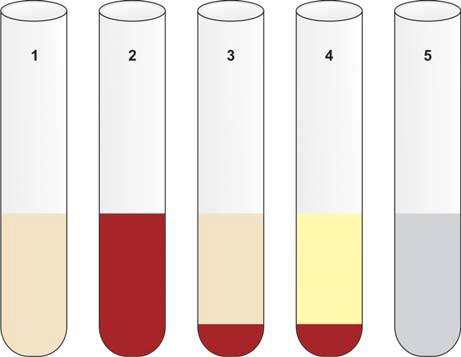
| Cerebrospinal fluid finding | Traumatic lumbar puncture | Subarachnoid hemorrhage |
| 1. Gross appearance | Blood more in initial tubes as compared to later tubes; Blood clots on standing. | Blood uniform in all tubes; Blood does not clot on standing |
| 2. Supernatant after centrifugation within 1 hour of collection | Clear | Pink or yellow (xanthochromia); yellow xanthochromia develops 12 hours after hemorrhage |
| 3. Microscopy | Progressive decrease of red cell counts in later tubes | Red cell counts uniform in all tubes; Hemosiderin-laden macrophages present |
| 4. Latex agglutination test for D-dimer* | Negative | Positive |
| 5. Cerebrospinal fluid pressure | Normal | Increased |
| 6. Cerebrospinal fluid protein | Normal | Increased |
| *D-dimer: A cross-linked fibrin degradation product |
3. Cell Counts in Cerebrospinal Fluid
(A) Total Leukocyte Count:
Cell count on CSF is done manually on the undiluted sample in a counting chamber.
Total leukocyte count increases in various disorders and along with differential count provides important diagnostic information. An increase in cell count in CSF is called as pleocytosis.
It is essential to do a microscopic examination of all CSF samples since white blood cell (WBC) count up to 200/cmm and red cell count up to 400/cmm are associated with the clear appearance of CSF.
For correct results:
- Cell count should be done as soon as possible after collection of CSF since cellular disintegration occurs rapidly. Cells also adhere to the walls of the glass tubes.
- CSF specimen collected in tube 3 should be used.
- No dilution of CSF is usually required. A diluent should be used only if CSF is cloudy and likely to contain increased leukocytes.
Method:
- CSF sample should be properly mixed. If CSF is clear, it is not diluted. If CSF appears cloudy or turbid, 1:20 dilution is made using 0.05 ml of CSF and 0.95 ml of Turk solution. (Composition of Turk solution: Glacial acetic acid 4 ml, methylene blue solution 10 drops, and distilled water to make 200 ml).
- The counting chamber is covered with the coverslip provided.
- The counting chamber is filled with the fluid and allowed to stand for 2 minutes for cells to settle.
- For counting cells in CSF, Fuchs-Rosenthal counting chamber is preferred because its depth is twice that of improved Neubauer chamber. In this, cells are counted in 5 large squares (4 corner squares and one central square).
- If undiluted CSF is used, total number of cells counted in 5 squares represents total count per cmm of CSF. If CSF is diluted, the number of cells counted is multiplied by the dilution factor (i.e. 20).
Causes of increased cell count in CSF:
- Meningitis and other infections of CNS
- Intracranial hemorrhage
- Meningeal infiltration by malignancy
- Repeated lumbar punctures
- Injection of foreign substances (e.g. radiographic contrast media, drugs) in subarachnoid space.
- Multiple sclerosis
Presence of blood in CSF due to traumatic tap or subarachnoid hemorrhage artefactually raises the leucocyte count by 1 WBC per 1000 red cells. This correction factor should be used if patient's hemogram is normal. If significant anemia or leukocytosis is present, then leukocyte count in CSF should be corrected as follows:
Corrected WBC count in CSF = WBC count in CSF (cells/cmm) – [(WBC count in blood × Red cell count in CSF) ÷ Red cell count in blood]
(B) Differential Leukocyte Count (DLC):
This provides information about relative proportion of various leukocytes.
If CSF contains only a few cells, then it is centrifuged at high speed (3000 g) for 10 minutes and a smear is made from the sediment. If CSF contains many cells, then a smear is made directly from the uncentrifuged sample. After staining with a Romanowsky stain, smear is examined under the microscope (Figure 1182.6).
Simple centrifugation of CSF often causes cell breakage and distortion. Cytospin preparation with cytocentrifuge (high speed centrifugation to concentrate cells on a slide in a uniform monolayer) has been recommended as it improves the cell yield and preserves the cell morphology well.
In normal adults, differential count shows 70% lymphocytes and 30% monocytes. In young children, a higher proportion of monocytes (up to 70%) are present. Table 1182.3 shows causes of increase in different types of leukocytes in CSF.
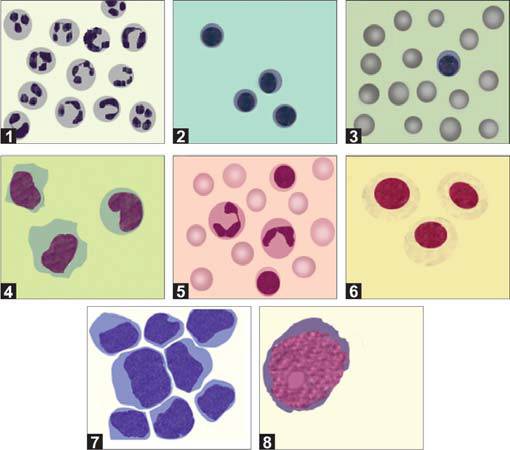

(C) Other Cells:
Apart from mature blood cells, CSF may contain immature hematopoietic cells, tissue cells (ependymal cells, pia arachnoid mesothelial cells) and malignant cells. CSF examination is commonly carried out in acute lymphoblastic leukemia to detect involvement of CNS. Increased WBC count (>5/μl) with lymphoblasts is evidence of CNS involvement.
4. Chemical Examination of Cerebrospinal Fluid
Routine chemical examination of CSF consists of estimation of proteins and glucose. CSF from tube 1 is used for chemical examination.
(1) Estimation of proteins in CSF:
Normal CSF protein level in adults is 15-45 mg/dl. An increase in CSF protein is a sensitive but non-specific indicator of CNS disease. CSF proteins may be normal during early stages of meningitis. Significant elevation (>150 mg/dl) occurs in bacterial meningitis.
There are various methods for estimation of CSF proteins. Turbidimetric method using trichloroacetic acid for precipitation of proteins is commonly used. In principle, trichloroacetic acid, when added to CSF, causes precipitation of proteins and a turbid solution is obtained. Amount of turbidity is compared with the turbidity of a known (standard) concentration of protein in a photoelectric colorimeter.
If a sample is contaminated with blood while doing the lumbar puncture (traumatic tap), false elevation of proteins will occur. This can be corrected by deducting 1 mg/dl of protein for every 1000 red cells per cmm. For this correction to be accurate, red cell count and proteins should be estimated in the sample from the same tube of CSF.
If facilities for estimation of CSF proteins are not available in the laboratory, then Pandy's test for globulins may be performed. In this test, CSF is added to saturated solution of phenol. If cloudiness develops immediately, it indicates presence of increased globulins and the test is reported as positive. If no cloudiness develops, the test is reported as negative (Figure 1182.7).
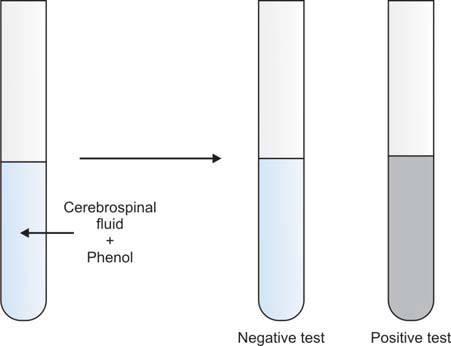
Along with CSF proteins, it is necessary to simultaneously measure serum proteins for proper interpretation of results.
CSF proteins are elevated in following conditions:
- An increased capillary permeability of blood-brain barrier: Meningitis
- Mechanical obstruction to the circulation of CSF (causing increased fluid reabsorption due to stasis): Spinal cord tumor
- Increased local (intrathecal) immunoglobulin (IgG) production: Multiple sclerosis, neurosyphilis, subacute sclerosing panencephalitis
- Both increased capillary permeability and increased local immunoglobulin (IgG) production: Guillain-Barré syndrome
- Hemorrhage in CSF: Traumatic tap, subarachnoid hemorrhage.
Marked elevation (>500 mg/dl) is noted in complete spinal block by a tumor, bacterial meningitis, and bloody CSF.
Differential diagnosis of elevated proteins in CSF (increased capillary permeability of blood-brain barrier vs. increased intrathecal synthesis of immunoglobulin G) can be made from parameters shown in Table 1182.4. Albumin is neither synthesized nor metabolized in CNS. Therefore, increased CSF albumin/serum albumin ratio indicates increased permeability of blood-brain barrier. Immunoglobulin G (IgG) can be synthesized in CNS. Therefore, increased CSF IgG/serum IgG ratio indicates either increased permeability of blood-brain barrier or increased intrathecal synthesis of IgG. Increased CSF IgG/albumin index indicates local IgG production.

(2) Estimation of glucose in CSF:
Normal CSF glucose is 2/3rds of blood glucose (CSF to blood glucose ratio is 0.6). A sample for blood glucose should be drawn 1 hour before LP for comparison with CSF glucose. After collection, CSF sample should be immediately processed for glucose estimation because falsely low result due to glycolysis may occur.
CSF glucose is measured by glucose oxidase method. Normal range is 45-80 mg/dl. CSF glucose <40 mg/dl is abnormal.
CSF glucose is decreased due to utilization by bacteria (pyogenic or tuberculous), leucocytes, or cancer cells in CSF.
Decreased CSF glucose occurs in following conditions:
- Acute bacterial meningitis
- Tuberculous meningitis
- Fungal meningitis
- Meningeal involvement by malignant tumor (meningeal carcinomatosis)
- Hypoglycemia
CSF glucose is normal in viral meningitis.
5. Microbiological Examination
Microbiological tests which can be carried out on CSF sample are—
- Direct wet mount of CSF: in suspected cases of cryptococcosis, amebic meningoencephalitis, Candida infection, and trypanosomiasis
- Gram's smear: should be done if CSF is turbid and neutrophils are increased.
- Ziehl-Neelsen smear: if tuberculous meningitis is suspected.
- Latex agglutination tests: for detection of bacterial and cryptococcal antigens.
- Serologic tests for syphilis
- Culture for bacteria and Mycobacterium tuberculosis
- Polymerase chain reaction for Mycobacterium tuberculosis and viruses.
(A) Direct Wet Mount of CSF:
One drop of CSF deposit (obtained after centrifugation) is placed on a glass slide, covered with a cover glass, and examined under the microscope with reduced illumination. Observe for motile trypanosomes or sluggishly moving amebae (Naegleria fowleri). N. fowleri is a free-living ameba in water which enters through the nose and reaches central nervous system. It causes a fatal type of hemorrhagic meningoencephalitis. Candida albicans may be seen in unstained wet mount; it appears as oval budding forms and as pseudohyphae.
When cryptococcal meningitis is clinically suspected, the wet mount is examined by dark-field microscopy. Alternatively, a drop of India ink is added to the drop of sediment on a glass slide, a coverslip is placed, and examined under the microscope using ×40 objective. Cryptococcus neoformans appears as spherical, budding yeast forms, 2-10 μ in diameter and surrounded by a large unstained capsule (Figure 1182.8). Cryptococci can be demonstrated by India ink preparation in 50% cases of cryptococcal meningitis.
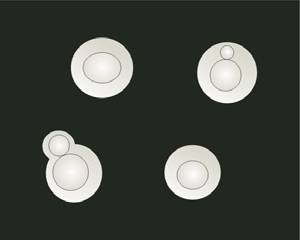
(B) Gram's Smear:
This must be done if CSF is purulent and neutrophils are increased. Gram's smear is positive in 80% untreated cases and 60% partially treated cases of bacterial meningitis. Therefore, absence of bacteria on Gram's smear does not rule out bacterial infection.

CSF is centrifuged and a smear of the deposit is made on a glass slide. (If CSF is purulent, smear is made directly without centrifugation). Smear is air-dried, stained with Gram's method, and examined under the oil-immersion lens for bacteria (Figure 1182.9). Bacteria which commonly cause meningitis are:
- Meningococci: Gram-negative diplococci located inside neutrophils.
- Pneumococci: Gram-positive diplococci surrounded by an unstained capsule.
- Hemophilus influenzae: Gram-negative coccobacilli.
- Escherichia coli: Gram-negative rods.
In all the above types of meninigitis, the accompanying cells are polymorphonuclear neutrophils.
Detection of typical bacteria on Gram-staining suggests the etiologic agent of meningitis. However, definitive diagnosis requires the culture of CSF.
There is an association between age of the patient and the causative organism of meningitis.
- 0 to 6 months: Group B streptococci, Escherichia coli, Listeria monocytogenes
- 6 months to 6 years: Streptococcus pneumoniae, Neisseria meningitidis, Hemophilus influenzae type B, Enteroviruses
- 6 to 60 years: Neisseria meningitides, Streptococcus pneumoniae, Enteroviruses, herpes simplex virus
- >60 years: Streptococcus pneumoniae, gram-negative bacilli, Listeria monocytogenes
(C) Ziehl-Neelsen Staining for Mycobacterium tuberculosis:
In tuberculous meningitis, number of tubercle bacilli is usually low in CSF. Ziehl-Neelsen or AFB staining is not a very sensitive method for detection of M. tuberculosis in CSF. AFB smears are negative in about 70% of cases of tuberculous meningitis. Fluorescent auramine stains have better sensitivity than Ziehl-Neelsen stain.
(D) Latex Agglutination Tests:
Latex agglutination tests for bacterial antigens are available commercially and are sensitive, rapid, and simple to perform. Currently available tests can detect N. meningitidis (groups A, B, C, Y, and W135), H. influenzae (capsular type B), S. pneumoniae and S. agalactiae. These tests are expensive and their sensitivity is similar to that of Gram's smear. Owing to the occurrence of false-positive results, these tests are not recommended for routine diagnosis of meningitis. These tests are particularly useful in patients who have been partially treated and in whom Gram's stain and culture are negative.
Latex agglutination tests for cryptococcal antigens are also available and have sensitivity of 90%. These tests have largely replaced India ink preparation for diagnosis of cryptococcal meningitis.
(E) Limulus Lysate Assay for Endotoxin Produced by Gram-negative Bacteria:
Limulus amebocyte lysate assay is a rapid, sensitive, and specific test for the presence of endotoxin. Endotoxin is produced by gram-negative bacteria like N. meningitides, H. influenzae type b, E. coli, and Pseudomonas. This test is particularly useful as a rapid test in newborns in whom these infections are common.
(F) Serologic Tests for Syphilis:
If fluorescent treponemal antibody with absorption (FTA-ABS) test is positive in serum, Venereal Disease Research Laboratory (VDRL) test should be done on CSF if neurosyphilis is suspected. VDRL test is highly specific but lacks sensitivity. Therefore, a positive test rules in but does not rule out the diagnosis of neurosyphilis. Other serological tests for syphilis are not suitable for the diagnosis of neurosyphilis in CSF.
Combination of positive FTA-ABS test in serum and reactive VDRL test in CSF is diagnostic of active neurosyphilis
(G) CSF Culture:
Culture of CSF is indicated if bacteria are seen on Gram-stained smear, or leukocytes or proteins are increased. Culture remains the gold standard for diagnois of bacterial meningitis. For culture, CSF collected in tube 2 is used. Sensitivity of culture for identification of bacteria is about 90%. In incompletely treated cases, sensitivity is less. Usually CSF sample is inoculated on chocolate (heated blood) agar and blood agar. In newborn infants, sample is also inoculated on McConkey's agar.
In tuberculous meningitis, culture for M. tuberculosis is positive in about 56% of cases. If a larger volume of CSF is used (i.e. 10 ml) for inoculation, sensitivity for detection increases.
In cryptococcal meningitis, culture is positive in 95% of cases.
(H) Polymerase Chain Reaction (PCR):
PCR is a highly specific and sensitive tool for diagnosis of infections of CNS. It uses probes to detect genes specific for the infecting organism. The test is rapid and requires only a small amount of CSF. High cost and availability only in a few specialist laboratories are major limitations. CSF PCR is mainly useful for diagnosis of viral infections of CNS (e.g. herpes simplex, enteroviruses, herpes zoster, etc.) and of tuberculous meningitis. CSF findings in different types of meningitis are shown in Table 1182.5.

6. Special Investigations
(A) CSF Protein Electrophoresis:
Protein electrophoresis of normal CSF differs from normal serum in (i) presence of a prominent transthyretin band and (ii) an extra transferrin band (called β2-transferrin or tau protein). Protein electrophoresis of CSF is used:
- For identification of oligoclonal bands, and
- To determine whether fluid submitted for examination is CSF.
- Oligoclonal bands: Agarose gel electrophoresis of concentrated CSF is used for detection of oligoclonal bands. These are two or more discrete bands in the gamma region. Presence of oligoclonal bands on CSF protein electrophoresis that are absent on concurrently run serum protein electrophoresis is indicative of intrathecal syntheis of immunoglobulins (Figure 1182.10). Oligoclonal bands have been identified in majority of patients (90%) with multiple sclerosis; however, they are not specific for this disorder. They are also seen in subacute sclerosing panencephalitis, viral CNS infections, neurosyphilis, and Guillain-Barré syndrome.
- CSF leakage: Occasionally, clear fluid leaking through the nose or ear after trauma or surgery is submitted for examination to determine whether it is CSF. Due to the risk of recurrent meningitis, accurate identification of such fluid as CSF is essential. Recommended test for this purpose is protein electrophoresis with immunofixation for transferrin. Protein electrophoresis of CSF shows an extra transferrin band (called as 'tau' protein), which is absent in other body fluids and secretions. Tau protein is an enzymatically modified transferrin that moves just behind the unaltered transferrin in β region. Identification of two isoform bands of transferrin on protein electrophoresis is a highly sensitive and specific test for identification of fluid as CSF (Figure 1182.11). Other body fluids or secretions do not show the second isoform band.
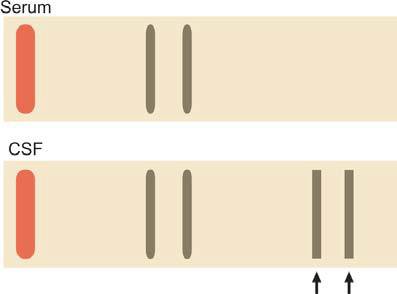
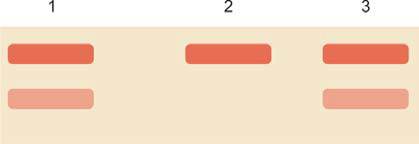
(B) Measurement of Albumin and Immunoglobulin G (IgG):
Comparison of IgG and albumin CSF/plasma ratio can be helpful for the diagnosis of multiple sclerosis (high ratio due to intrathecal synthesis of IgG).
REFERENCE RANGES
Reference ranges are given at the beginning of this article under "Composition of normal cerebrospinal fluid in adults".
CRITICAL VALUES
References
- Riordan FAI, Cant AJ. When to do a lumbar puncture. Arch Dis Child 2002;87:235-7.
- Seehusen DA, Reeves MM, Fomin DA. Cerebrospinal fluid analysis. Am Fam Physician 2003;68:1103-8.
- Comment
- Posted by Dayyal Dg.
- Pathology
- Clinical Pathology
- Pathology Notes
- Examination of CSF
- Examination of Cerebrospinal Fluid
- Lab Test
- Lab Test Procedure
- Chemical Pathology
- microscopic examination of cerebrospinal fluid reveals amoebae
- physical examination of cerebrospinal fluid
- microscopic examination of cerebrospinal fluid
- laboratory examination of cerebrospinal fluid
- biochemical examination of cerebrospinal fluid
- cytological examination of cerebrospinal fluid
- microbiological examination of cerebrospinal fluid
- chemical examination of cerebrospinal fluid